Excretion and Osmoregulation
1. Choose correct option
A. Which one of the following organisms would spend maximum energy in production of nitrogenous waste?
a. Polar bear b. Flamingo
c. Frog d. Shark
Answer: b. Flamingo
- Explanation: Flamingos, being uricotelic birds, expend more energy to convert ammonia into uric acid, which requires more energy compared to ammonotelic or ureotelic organisms.
B. In human beings, uric acid is formed due to metabolism of __________.
a. amino acids b. fatty acids
c. creatinine d. nucleic acids
Answer: d. nucleic acids
- Explanation: Uric acid is primarily formed from the breakdown of purines, which are components of nucleic acids.
C. Visceral layer : Podocytes :: PCT : _______
a. Cilliated cells
b. Squamous cells
c. Columnar cells
d. Cells with brush border
Answer: d. Cells with brush border
- Explanation: The visceral layer of Bowman’s capsule consists of podocytes, while the proximal convoluted tubule (PCT) is lined with cells having a brush border (microvilli) for reabsorption.
D. Deproteinised plasma is found in __________.
a. Bowman’s capsule
b. Descending limb
c. Glomerular capillaries
d. Ascending limb
Answer: a. Bowman’s capsule
- Explanation: Deproteinised plasma, or glomerular filtrate, is formed in Bowman’s capsule after ultrafiltration in the glomerulus.
E. Specific gravity of urine would _______ if level of ADH increases.
a. remain unaffected b. increases
c. decreases d. stabilise
Answer: b. increases
- Explanation: ADH increases water reabsorption in the collecting ducts, concentrating the urine and increasing its specific gravity.
F. What is micturition?
a. Urination b. Urine formation
c. Uremia c. Urolithiasis
Answer: a. Urination
- Explanation: Micturition is the process of expelling urine from the urinary bladder.
G. Which one of the following organisms excrete waste through nephridia?
a. Cockroach b. Earthworm
c. Crab d. Liver Fluke
Answer: b. Earthworm
- Explanation: Earthworms excrete waste through metanephridia, which are coiled tubes opening to the exterior via nephridiopores.
H. Person suffering from kidney stone is advised not to have tomatoes as it has _______.
a. seeds b. lycopene
c. oxalic acid d. sour taste
Answer: c. oxalic acid
- Explanation: Tomatoes contain oxalic acid, which can contribute to the formation of calcium oxalate kidney stones.
I. Tubular secretion does not take place in ________.
a. DCT b. PCT
d. collecting duct d. Henle’s loop
Answer: d. Henle’s loop
- Explanation: Tubular secretion occurs in the PCT, DCT, and collecting duct, but not in the Loop of Henle.
J. The minor calyx ____________.
a. collects urine
b. connects pelvis to ureter
c. is present in the cortex
d. receives column of Bertini
Answer: a. collects urine
- Explanation: Minor calyces collect urine from the renal papillae and channel it into major calyces.
K. Which one of the followings is not a part of human kidney?
a. Malpighian body
b. Malpighian tubule
c. Glomerulus
d. Loop of Henle
Answer: b. Malpighian tubule
- Explanation: Malpighian tubules are found in insects, not in human kidneys.
L. The yellow colour of the urine is due to presence of ___________
a. uric acid b. cholesterol
c. urochrome d. urea
Answer: c. urochrome
- Explanation: Urochrome, a pigment derived from hemoglobin breakdown, gives urine its yellow color.
M. Hypotonic filtrate is formed in _______
a. PCT b. DCT c. LoH d. CT
Answer: b. DCT
- Explanation: The filtrate becomes hypotonic in the DCT due to active reabsorption of solutes like Na+ and Cl-.
N. In reptiles, uric acid is stored in _____
a. cloaca b. fat bodies
c. liver d. anus
Answer: a. cloaca
- Explanation: Reptiles store uric acid in the cloaca before excretion.
O. The part of nephron which absorbs glucose and amino acid is______
a. collecting tubule
b. proximal tubule
c. Henle’s loop
d. DCT
Answer: b. proximal tubule
- Explanation: The PCT actively reabsorbs glucose and amino acids from the glomerular filtrate.
P. Bowman’s capsule is located in kidney in the ________
a. cortex b. medulla
c. pelvis d. pyramids
Answer: a. cortex
- Explanation: Bowman’s capsule is located in the renal cortex, where filtration occurs.
Q. The snakes living in desert are mainly__________
a. aminotelic b. ureotelic
c. ammonotelic d. uricotelic
Answer: d. uricotelic
- Explanation: Desert snakes are uricotelic, excreting uric acid to conserve water in arid environments.
R. Urea is a product of breakdown of ___________
a. fatty acids b. amino acids
c. glucose d. fats
Answer: b. amino acids
- Explanation: Urea is formed from the deamination of amino acids in the liver.
S. Volume of the urine is regulated by__________
a. aldosterone b. ADH
c. both a and b d. none
Answer: c. both a and b
- Explanation: Aldosterone and ADH regulate urine volume by controlling sodium and water reabsorption, respectively.
2. Answer the following questions
A. Doctors say Mr. Shaikh is suffering from urolithiasis. How it could be explained in simple words?
Answer: Urolithiasis means Mr. Shaikh has kidney stones, which are hard deposits formed in the urinary tract. These stones can cause pain and difficulty in passing urine.
B. Anitaji needs to micturate several times and feels very thirsty. This is an indication of change in permeability of certain part of nephron. Which is this part?
Answer: The collecting duct. Increased permeability due to low ADH levels (as in diabetes insipidus) reduces water reabsorption, leading to frequent urination and thirst.
C. Effective filtration pressure was calculated to be 20 mm Hg; where glomerular hydrostatic pressure was 70 mm of Hg. Which other pressure is affecting the filtration process? How much is it?
Answer: The other pressures are osmotic pressure of blood (30 mm Hg) and capsular hydrostatic pressure (15 mm Hg). Their combined effect is 45 mm Hg (30 + 15).
- Calculation: EFP = Glomerular hydrostatic pressure – (Osmotic pressure + Capsular pressure) = 70 – (30 + 15) = 20 mm Hg.
D. Name any one guanotelic organism.
Answer: Spider.
E. Why are kidneys called ‘retroperitoneal’?
Answer: Kidneys are called retroperitoneal because they are located behind the peritoneum, the membrane lining the abdominal cavity, and are not fully enclosed by it.
F. State role of liver in urea production.
Answer: The liver converts toxic ammonia, produced from amino acid deamination, into urea via the ornithine/urea cycle, which is less toxic and excreted by the kidneys.
G. Why do we get bad breath after eating garlic or raw onion?
Answer: Garlic and onions contain volatile substances that are absorbed into the bloodstream and excreted through the lungs, causing bad breath.
3. Answer the following questions
A. John has two options as treatment for his renal problem : Dialysis or kidney transplants. Which option should he choose? Why?
Answer: John should choose a kidney transplant if he is medically eligible. Dialysis is a temporary measure that filters blood artificially but cannot replicate all kidney functions, such as hormone production (e.g., erythropoietin, renin, calcitriol). A transplant offers a long-term solution, restoring normal kidney function and improving quality of life, though it requires immunosuppressants to prevent rejection.
B. Amphibian tadpole can afford to be ammonotelic. Justify.
Answer: Amphibian tadpoles are ammonotelic because they live in aquatic environments with abundant water. Ammonia, being highly toxic, requires large amounts of water for dilution and excretion through gills and skin. The aquatic habitat allows tadpoles to excrete ammonia safely without conserving water, unlike terrestrial adult frogs, which are ureotelic.
C. Birds are uricotelic in nature. Give reason.
Answer: Birds are uricotelic to conserve water, as uric acid is least toxic and requires minimal water for excretion (5–10 ml per gram). This adaptation suits their terrestrial and flying lifestyle, reducing the need to carry excess water weight.
4. Write the explanation in your word
A. Nitya has been admitted to hospital after heavy blood loss. Till proper treatment could be given; how did Nitya’s body must have tackled the situation?
Answer: After heavy blood loss, Nitya’s body would activate mechanisms to restore blood volume and pressure. The juxtaglomerular apparatus (JGA) in the kidneys would detect reduced blood flow and release renin. Renin converts angiotensinogen (from the liver) into angiotensin I, which is then converted to angiotensin II by angiotensin-converting enzyme. Angiotensin II constricts kidney arterioles to raise blood pressure, stimulates the proximal convoluted tubule to reabsorb more sodium, chloride, and water, and triggers the adrenal cortex to release aldosterone. Aldosterone enhances sodium and water reabsorption in the distal convoluted tubule and collecting ducts, increasing blood volume. Additionally, osmoreceptors in the hypothalamus would detect increased blood osmolarity due to fluid loss and stimulate the release of antidiuretic hormone (ADH) from the posterior pituitary. ADH increases water reabsorption in the collecting ducts, concentrating urine and conserving water to restore blood volume. These mechanisms work together to stabilize Nitya’s condition until medical treatment is provided.
5. Complete the diagram / chart with correct labels / information. Write the conceptual details regarding it.
Answer:
The composition of urine depends upon food and fluid consumed by an individual. There are two ways in which it the composition is regulated. They are as follows:
i. Regulating water reabsorption through ADH
ii. Electrolyte reabsorption though RAAS
iii. Atrial Natriuretic Peptide
i. Regulating water reabsorption through ADH:
Hypothalamus in the midbrain has special receptors called osmoreceptors which can detect change in osmolarity (measure of total number of dissolved particles per liter of solution) of blood.
If osmolarity of blood increases due to water loss from the body (after eating namkeen or due to sweating), osmoreceptors trigger release of Antidiuretic hormone (ADH) from neurohypophysis (posterior pituitary). ADH stimulates reabsorption of water from last part of DCT and entire collecting duct by increasing the permeability of cells.
This leads to reduction in urine volume and decrease in osmolarity of blood.
Once the osmolarity of blood comes to normal, activity of osmoreceptor cells decreases leading to decrease in ADH secretion. This is called negative feedback.
In case of hemorrhage or severe dehydration too, osmoreceptors stimulate ADH secretion. ADH is important in regulating water balance through kidneys.
In absence of ADH, diuresis (dilution of urine) takes place and person tends to excrete large amount of dilute urine. This condition called as diabetes insipidus.
ii. Electrolyte reabsorption through RAAS:
Another regulatory mechanism is RAAS (Renin Angiotensin Aldosterone System) by Juxta Glomerular Apparatus (JGA).
Whenever blood supply (due to change in blood pressure or blood volume) to afferent arteriole decreases (e.g. low BP/dehydration), JGA cells release Renin. Renin converts angiotensinogen secreted by hepatocytes in liver to Angiotensin I. ‘Angiotensin converting enzyme’ further modifies Angiotensin I to Angiotensin II, the active form of hormone. It stimulates adrenal cortex to release another hormone called aldosterone that stimulates DCT and collecting ducts to reabsorb more Na+ and water, thereby increasing blood volume and pressure.
iii. Atrial natriuretic peptide (ANP): A large increase in blood volume and pressure stimulates atrial wall to produce atrial natriuretic peptide (ANP). ANP inhibits Na+ and Cl– reabsorption from collecting ducts inhibits release of renin, reduces aldosterone and ADH release too. This leads to a condition called Natriuresis (increased excretion of Na+ in urine) and diuresis.
Answer:
- Nephrons are structural and functional units of kidney.
- Each nephron consists of a 4 – 6 cm long, thin-walled tube called the renal tubule and a bunch of capillaries known as the glomerulus.
- The wall of the renal tubule is made up of a single layer of epithelial cells.
- Its proximal end is wide, blind, cup-like and is called as Bowman’s capsule, whereas the distal end is open.
- The nephron is divisible into Ilowman’s capsule, neck, proximal convoluted tubule (PCT), Loop of Henle (LoH), distal convoluted tubule (DCT) and collecting tubule (CT).
- The glomerulus is present in the cup-like cavity of Bowman’s capsule and both are collectively known as renal corpuscle or Malpighian body.
Answer:
Nephron is the structural and functional unit of kidney.
Structure of nephron:
A nephron (uriniferous tubule) is a thin walled, coiled duct, lined by a single layer of epithelial cells. Each nephron is divided into two main parts:
i. Malpighian body
ii. Renal tubule
Malpighian body: Each Malpighian body is about 200pm in diameter and consists of a Bowman’s capsule and glomerulus.
a. Glomerulus:
- Glomerulus is a bunch of fine blood capillaries located in the cavity of Bowman’s capsule.
- A small terminal branch of the renal artery, called as afferent arteriole enters the cup cavity (Bowman capsule) and undergoes extensive fine branching to form network of several capillaries. This bunch is called as glomerulus.
- The capillary wall is fenestrated (perforated).
All capillaries reunite and form an efferent arteriole that leaves the cup cavity.
The diameter of the afferent arteriole is greater than the efferent arteriole. This creates a high hydrostatic pressure essential for ultrafiltration, in the glomerulus.
b. Bowman’s capsule:
- It is a cup-like structure having double walls composed of squamous epithelium.
- The outer wall is called as parietal wall and the inner wall is called as visceral wall.
- The parietal wall is thin consisting of simple squamous epithelium.
- There is a space called as capsular space / urinary space in between two walls.
- Visceral wall consists of special type of squamous cells called podocytes having a foot-like pedicel. These podocytes are in close contact with the walls of capillaries of glomerulus.
- There are small slits called as filtration slits in between adjacent podocytes.
ii. Renal tubule:
a. Neck:
The Bowman’s capsule continues into the neck. The wall of neck is made up of ciliated epithelium. The lumen of the neck is called the urinary pole. The neck leads to proximal convoluted tubule.
b. Proximal Convoluted Tubule :
This is highly coiled part of nephron which is lined by cuboidal cells with brush border (microvilli) and surrounded by peritubular capillaries. Selective reabsorption occurs in PCT. Due to convolutions (coiling), filtrate flows slowly and remains in the PCT for longer duration, ensuring that maximum amount of useful molecules are reabsorbed.
c. Loop of Henle :
- This is ‘U’ shaped tube consisting of descending and ascending limb.
- The descending limb is thin walled and permeable to water and lined with simple squamous epithelium.
- The ascending limb is thick walled and impermeable to water and is lined with simple cuboidal epithelium.
The LoH is surrounded by capillaries called vasa recta. - Its function is to operate counter current system – a mechanism for osmoregulation.
- The ascending limb of Henle’s loop leads to DCT.
d. Distal convoluted tubule:
- This is another coiled part of the nephron.
- Its wall consists of simple cuboidal epithelium.
- DCT performs tubular secretion / augmentation / active secretion in which, wastes are taken up from surrounding capillaries and secreted into passing urine.
- DCT helps in water reabsorption and regulation of pH of body fluids.
e. Collecting tubule:
- This is a short, straight part of the DCT which reabsorbs water and secretes protons.
- The collecting tubule opens into the collecting duct.
Answer:
The composition of urine depends upon food and fluid consumed by an individual. There are two ways in which it the composition is regulated. They are as follows:
i. Regulating water reabsorption through ADH
ii. Electrolyte reabsorption though RAAS
iii. Atrial Natriuretic Peptide
i. Regulating water reabsorption through ADH:
Hypothalamus in the midbrain has special receptors called osmoreceptors which can detect change in osmolarity (measure of total number of dissolved particles per liter of solution) of blood.
If osmolarity of blood increases due to water loss from the body (after eating namkeen or due to sweating), osmoreceptors trigger release of Antidiuretic hormone (ADH) from neurohypophysis (posterior pituitary). ADH stimulates reabsorption of water from last part of DCT and entire collecting duct by increasing the permeability of cells.
This leads to reduction in urine volume and decrease in osmolarity of blood.
Once the osmolarity of blood comes to normal, activity of osmoreceptor cells decreases leading to decrease in ADH secretion. This is called negative feedback.
In case of hemorrhage or severe dehydration too, osmoreceptors stimulate ADH secretion. ADH is important in regulating water balance through kidneys.
In absence of ADH, diuresis (dilution of urine) takes place and person tends to excrete large amount of dilute urine. This condition called as diabetes insipidus.
ii. Electrolyte reabsorption through RAAS:
Another regulatory mechanism is RAAS (Renin Angiotensin Aldosterone System) by Juxta Glomerular Apparatus (JGA).
Whenever blood supply (due to change in blood pressure or blood volume) to afferent arteriole decreases (e.g. low BP/dehydration), JGA cells release Renin. Renin converts angiotensinogen secreted by hepatocytes in liver to Angiotensin I. ‘Angiotensin-converting enzyme’ further modifies Angiotensin I to Angiotensin II, the active form of hormone. It stimulates adrenal cortex to release another hormone called aldosterone that stimulates DCT and collecting ducts to reabsorb more Na+ and water, thereby increasing blood volume and pressure.
iii. Atrial natriuretic peptide (ANP): A large increase in blood volume and pressure stimulates atrial wall to produce atrial natriuretic peptide (ANP). ANP inhibits Na+ and Cl– reabsorption from collecting ducts inhibits release of renin, reduces aldosterone and ADH release too. This leads to a condition called Natriuresis (increased excretion of Na+ in urine) and diuresis.
Answer:
- When renal function of a person falls below 5 – 7 %, accumulation of harmful substances in blood begins. In such a condition the person has to go for artificial means of filtration of blood i.e. haemodialysis.
- In haemodialysis, a dialysis machine is used to filter blood. The blood is filtered outside the body using a dialysis unit.
- In this procedure, the patients’ blood is removed; generally from the radial artery and passed through a cellophane tube that acts as a semipermeable membrane.
- The tube is immersed in a fluid called dialysate which is isosmotic to normal blood plasma. Hence, only excess salts if present in plasma pass through the cellophane tube into the dialysate.
- Waste substances being absent in the dialysate, move from blood into the dialyzing fluid.
- Filtered blood is returned to vein.
- In this process it is essential that anticoagulant like heparin is added to the blood while it passing through the tube and before resending it into the circulation, adequate amount of anti-heparin is mixed.
- Also, the blood has to move slowly through the tube and hence the process is slow.
6. Prove that mammalian urine contains urea.
Answer:
- Urea is a nitrogenous waste formed by breakdown of protein (deamination of amino acids).
- During this process, amino groups are removed from the amino acids present in the proteins and converted to highly toxic ammonia. The ammonia is finally converted to area through ornithine cycle. Thus, the urea formed is passed to kidneys and excreted out of the body through urine.
- Reabsorption of urea (proximal tubule, collecting ducts) and active secretion of urea (Henle loop) leads to a urea circulation (urea recycling) between the lumen of the nephron and renal medulla, which is an important element of the renal urine concentration.
- About 54 g of urea is filtered per day in the glomerular capsule, of which approximately 30 g is excreted in the urine and 24 g is reabsorbed into blood (assuming GFR is 180 litres/day).
- Urinalysis can help detect the amount of urea in urine (Urine urea nitrogen test, urease test, etc.).

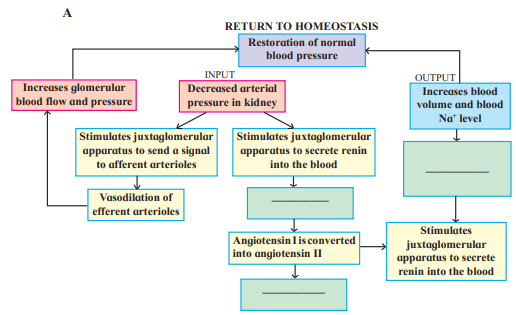
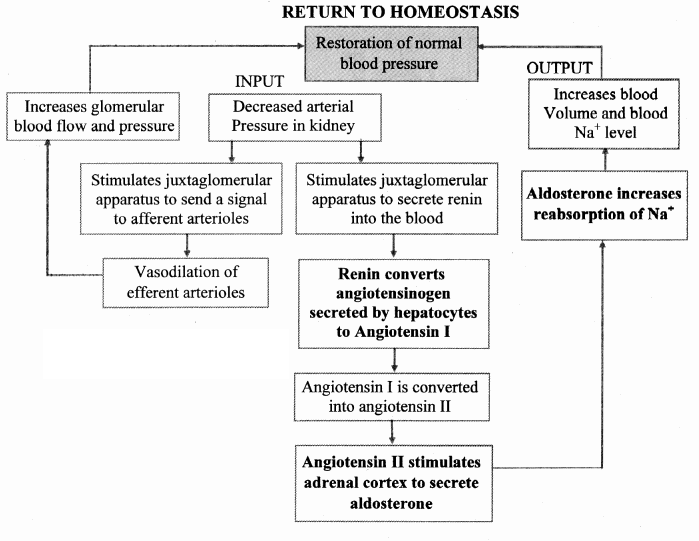
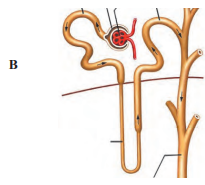
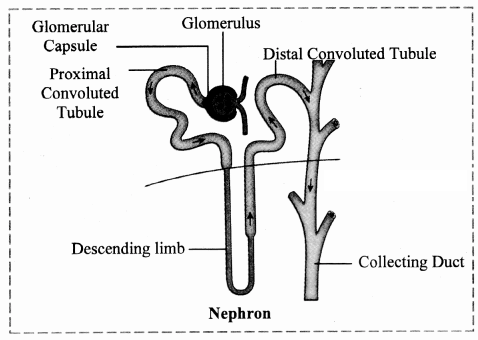


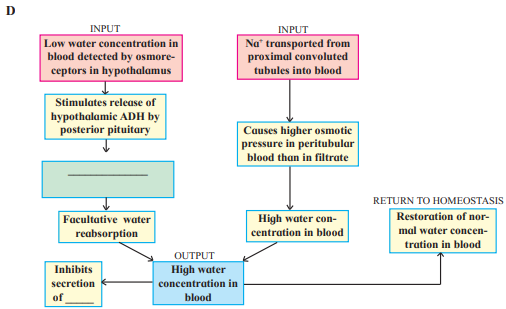
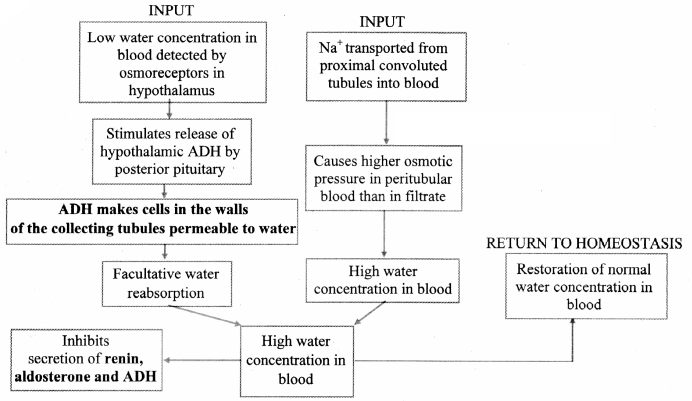
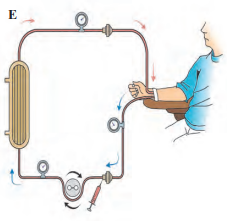
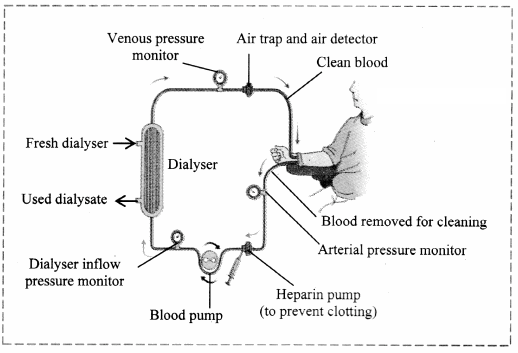
Leave a Reply